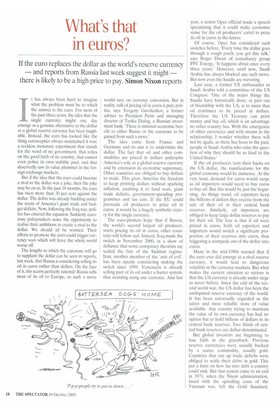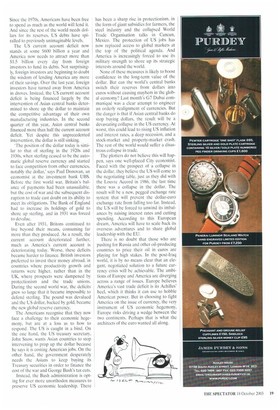What's that in euros?
If the euro replaces the dollar as the world's reserve currency — and reports from Russia last week suggest it might — there is likely to be a high price to pay. Simon Nixon reports It has always been hard to imagine what the problem must be to which the answer is the euro. For most of the past three years, the idea that the single currency might one day emerge as a genuine alternative to the dollar as a global reserve currency has been laughable. Instead, the euro has looked like the thing eurosceptics always maintained it was: a reckless monetary experiment that stands for the word of no government, that relies on the good faith of no country, that cannot even police its own stability pact, and that deservedly saw its value plummet in the foreign exchange markets.
But if the idea that the euro could become a rival to the dollar was a joke, then the joke may be on us. In the past 18 months, the euro has risen more than 30 per cent against the dollar. The dollar was already buckling under the strain of America's giant trade and budget deficits. Now, following the Iraq war, politics has entered the equation. Suddenly eurozone policymakers sense the opportunity to realise their ambitions to create a rival to the dollar. We should all be worried. Their efforts to promote the euro could trigger currency wars which will leave the whole world worse off.
The lengths to which the eurozone will go to supplant the dollar can be seen in reports, last week, that Russia is considering selling its oil in euros rather than dollars. On the face of it, this seems perfectly rational: Russia sells most of its oil to Europe, so such a move would save on currency conversion. But in reality, talk of pricing oil in euros is pure politics, says Yevgeny Gavrilenkov, a former adviser to President Putin and managing director of Troika Dialog, a Russian investment bank. 'There is minimal economic benefit to either Russia or the eurozone to be gained from such a move.'
The idea came from France and Germany and its aim is to undermine the dollar. The fact that oil and other commodities are priced in dollars underpins America's role as a global reserve currency and by extension its economic supremacy. Other countries are obliged to buy dollars to trade. This gives America the freedom to keep printing dollars without sparking inflation, enabling it to fund wars, giant trade deficits, government-spending programmes and tax cuts. If the EU could persuade oil producers to price oil in euros, it would be a hugely symbolic victory for the single currency.
The euro-plotters hope that if Russia, the world's second largest oil producer, starts pricing its oil in euros, other countries will follow suit. Indeed, Iraq made the switch in November 2000, in a show of defiance that some conspiracy theorists say sealed the fate of the Saddam regime. Iran, another member of the 'axis of evil', has been openly considering making the switch since 1999. Venezuela is already selling part of its oil under a barter system, thus avoiding using any currency. And last
year, a senior Opec official made a speech speculating that it could make economic sense for the oil producers' cartel to price its oil in euros in the future.
Of course, Opec has considered such switches before. 'Every time the dollar goes through a rough patch, you get this talk,' says Roger Diwan of consultancy group PFC Energy. 'It happens about once every three years.' However, until now, Saudi Arabia has always blocked any such move. But now even the Saudis are wavering.
Last year, a former US ambassador to Saudi Arabia told a committee of the US Congress: 'One of the major things the Saudis have historically done, in part out of friendship with the US, is to insist that oil continues to be priced in dollars. Therefore the US Treasury can print money and buy oil, which is an advantage no other country has. With the emergence of other currencies and with strains in the relationship, I wonder whether there will not be again, as there has been in the past, people in Saudi Arabia who raise the question of why they should be so kind to the United States.'
If the oil producers turn their backs on the US dollar, the ramifications for the global economy would be immense. At the very least, demand for euros would surge as oil importers would need to buy euros to buy oil. But this would be just the beginning. As things stand, oil exporters keep the billions of dollars they receive from the sale of their oil in their central bank reserves. Similarly, oil importers are obliged to keep large dollar reserves to pay for their oil. The fear is that if oil were priced in euros, both oil exporters and importers would switch a significant proportion of their reserves into euros, thus triggering a stampede out of the dollar into euros.
Many in the mid-1990s warned that if the euro ever did emerge as a rival reserve currency, it would lead to dangerous volatility in the currency markets. But what makes the current situation so serious is that the US currency is already under siege as never before. Since the end of the second world war, the US dollar has been the undisputed reserve currency of the world. It has been universally regarded as the safest and most reliable store of value available. Any country trying to maintain the value of its own currency has had no option but to hold billions of dollars in its central bank reserves. Two thirds of central bank reserves are dollar-denominated.
But global investors are beginning to lose faith in the greenback. Previous reserve currencies were usually backed by a scarce commodity, usually gold. Countries that ran up trade deficits were obliged to settle their debts in gold. This put a limit on how far into debt a country could sink. But that system came to an end in 1971, when the Nixon administration, faced with the spiralling costs of the Vietnam war, left the Gold Standard.
Since the 1970s, Americans have been free to spend as much as the world will lend it. And since the rest of the world needs dollars for its reserves, US debts have spiralled to previously unimaginable levels.
The US current account deficit now stands at some $600 billion a year and America now needs to attract more than S1.5 billion every day from foreign investors to fund its debts. Not surprisingly, foreign investors are beginning to doubt the wisdom of lending America any more of their savings. Over the last year, foreign investors have turned away from America in droves. Instead, the US current account deficit is being financed largely by the intervention of Asian central banks determined to shore up the dollar to maintain the competitive advantage of their own manufacturing industries. In the second quarter of this year, Asian central banks financed more than half the current account deficit. Yet despite this unprecedented intervention, the dollar is still sinking.
'The position of the dollar today is similar to that of sterling in the 1920s and 1930s, when sterling ceased to be the auto matic global reserve currency and started to face competition from other currencies, notably the dollar,' says Paul Donovan, an economist at the investment bank UBS. Before the first world war. Britain's bal ance of payments had been unassailable, but the cost of war and the subsequent disruption to trade cast doubt on its ability to meet its obligations. The Bank of England had to increase its holdings of gold to shore up sterling, and in 1931 was forced to devalue.
Even after 1931, Britons continued to live beyond their means, consuming far more than they produced. As a result, the current account deteriorated further, much as America's current account is deteriorating today. Worse, these deficits became harder to finance. British investors preferred to invest their money abroad, in countries where productivity growth and returns were higher, rather than in the UK, where prospects were dampened by protectionism and the trade unions.
During the second world war, the deficits grew so large that it became impossible to defend sterling. The pound was devalued and the US dollar, backed by gold, became the new global reserve currency.
The Americans recognise that they now face a challenge to their economic hege mony, but are at a loss as to how to respond. The US is caught in a bind. On the one hand, the US treasury secretary, John Snow, wants Asian countries to stop intervening to prop up the dollar because he says it is costing American jobs. On the other hand, the government desperately needs the Asians to keep buying its Treasury securities in order to finance the cost of the war and George Bush's tax cuts. Instead. the Bush administration is opting for ever more unorthodox measures to preserve US economic leadership. There has been a sharp rise in protectionism, in the form of giant subsidies for farmers, the steel industry and the collapsed World Trade Organisation talks in Cancun, Mexico. The protection of US jobs has now replaced access to global markets at the top of the political agenda. And America is increasingly forced to use its military strength to shore up its strategic interests around the world.
None of these measures is likely to boost confidence in the long-term value of the dollar. But can the world's central banks switch their reserves from dollars into euros without causing mayhem in the glob al economy? Last month's G7 Dubai com muniqué was a clear attempt to engineer an orderly realignment of currencies. But the danger is that if Asian central banks do stop buying dollars, the result will be a devastating collapse in the US currency. At worst, this could lead to rising US inflation and interest rates, a deep recession, and a stock-market and property-market crash. The rest of the world would suffer a disastrous collapse in trade.
The plotters do not believe this will happen, says one well-placed City economist.
Faced with the prospect of a collapse in
the dollar, they believe the US will come to the negotiating table, just as they did with the Louvre Accord in 1986, the last time there was a collapse in the dollar. The result will be a new, pegged exchange rate system that will prevent the dollar-euro exchange rate from falling too far. Instead, the US will be forced to unwind its imbal ances by raising interest rates and cutting spending. According to this European dream, America will have to scale back its overseas adventures and to share global leadership with the EU.
There is no doubt that those who are pushing for Russia and other oil-producing countries to price their oil in euros are playing for high stakes. In the post-Iraq world, it is by no means clear that an ele gant, negotiated solution to a future cur rency crisis will be achievable. The ambitions of Europe and America are diverging across a range of issues. Europe believes America's vast trade deficit is its Achilles' heel, which it thinks it can use to hobble American power. But in choosing to fight America on the issue of currency, the very instrument of US economic hegemony.
Europe risks driving a wedge between the two continents. Perhaps that is what the architects of the euro wanted all along.



































































































 Previous page
Previous page